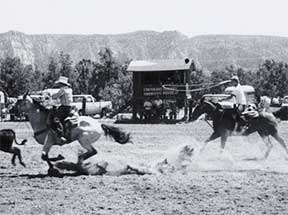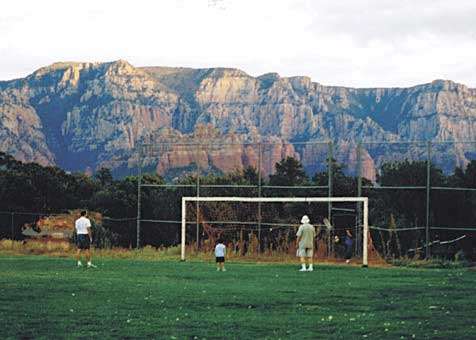By James Bishop Jr.

A secret to too many!
A man who has a vision is not able to use that power until he has performed that vision on earth for the people to see.
– Black Elk
Writing about what he observed in the U.S. in the 1830s, Alexis de Tocqueville judged Americans to be “avaricious, self-serving, and aggressive.”
But he was also amazed at their collective keenness to join together in one cause or another, the fruits of that concern for community being libraries, historical societies, hospitals, and yes – parks.
And, amazed also, by those citizen volunteers who created and sustained parks back when they were the heart of small towns, of neighborhoods, when they were invigorating places for picnics, concerts, neighborly gatherings and such.
What happened?
Where did they go?
According to conventional wisdom, municipal budget crunches across the U.S. have drained resources for programs and maintenance so that the resulting neglect has left many of the nation’s parks “empty, or, worse, dangerous.”
Not so in Sedona.
Here, the future is now, up on the Posse Grounds, a lively small-town park, that features a view-shed to melt the heart of a banker, tennis courts, a sky blue swimming pool, two lush ball fields, a renovated soccer field, covered ramadas for quiet picnics – while children play on the new playground equipment – while a sand volley ball court occupies some older folks.
Although their names are not etched into pavers or in red rock walls anywhere yet, some old-timers remember the citizens that first created activities and marvel at the park’s evolution as the years unfolded. Together, those volunteers found that satisfaction was not just in creating a pretty place, but a way to gain a powerful sense of bonding and achievement.
Cindy Rovey, who came to Sedona in 1976, found that the school, the pool, the ball fields, and the area where the Coconino County Sheriff’s posse roped and real cowboys did their stuff, were in place.
 She was struck by how many of Sedona’s citizens were involved, some of whom are still here and continue to be active in Sedona, or, at least, are still around. For openers, some of them are listed here: Bill Garland, George Coakley, Heidi Lawler, Dave Blauert, Steve Ash, Robert Larson, Jack Seeley, Bruce Rogers, Gail Herrick, Charlie Crick, and Len Barrow, who was a teacher at the school and ran Little League baseball forever.
She was struck by how many of Sedona’s citizens were involved, some of whom are still here and continue to be active in Sedona, or, at least, are still around. For openers, some of them are listed here: Bill Garland, George Coakley, Heidi Lawler, Dave Blauert, Steve Ash, Robert Larson, Jack Seeley, Bruce Rogers, Gail Herrick, Charlie Crick, and Len Barrow, who was a teacher at the school and ran Little League baseball forever.
Some of those people made up the first Parks and Recreation commission when the park was turned over to them in 1989, shortly after the city incorporated.
Bill Garland was the first Parks & Rec chair. Up until then, the land was leased from the state by an organization called the Sedona Community Center and was paid for with some grants and in-kind matching funds from local builders – business men and with private funds.
A review of activities back in that day also offers a quick look at Sedona’s history:
- 1953 – First Sheriff’s Posse Parade and start of rodeos.
- In the summer of 1953, Stagecoach Players of Oak Creek built the first wooden stage.
- 1962 – First ball field built.
- 1969 – Groundbreaking for Sedona Community Park and Recreation Grounds. The land was a portion of 137.5-acre land exchange and leased by the state to Yavapai County. Twenty-two acres were set aside for schools, 15 acres for Sheriff’s Posse. Various organizations were to lease land, ranging from the Little League to the Sedona Westerners, Sedona Arts Center and many more.
- In 1975 – the pool was built and the Marine Corps built the first dugouts and the snack bar.
- In 1979 – the Lions Club installed the first water fountain.
- In 1982 – the first Jazz on the Rocks sponsored by The Sedona Arts Center Citizens fixed up the stage and cleared the land, installed a drip system and seeded the site.
- 1989 – Jazz on the Rocks held it last concert, their audience had become too large.During that same year, Yavapai College launched an “institutional taking” of 8.63 acres that was surrounded by the Posse Ground Community Park. Citizen Barbara Antonsen organized a program to discourage that plan. In 1993, the college backed off and the city of Sedona purchased the land in 1994.On December 10, 2002, the city approved naming this area in honor of Barbara Antonsen. A few months later she died.
- 2005-2008 – at the request of the city, a volunteer group came together to raise funds to create a modest covered stage structure, and to renew and restore the park’s ecosystem with an efficient watering system, local grass, benches, picnic tables and landscaping.
“I support this effort,” said Joe Martori, president and ceo of ILX Resorts. “Sedona’s legacy is on that land – the first Sedona Art Festival, Jazz on the Rocks, Pops concerts, rodeos, chuck wagon dinners, county fairs, St. Patrick days …… and so much more, even a carnival.”
One of Sedona’s undersung talents, raconteur, musician, and connoisseur of adult beverages, Randall Mahannah remembers the old days: “Impressions from a distant memory … I’m thinking 1971-72. The Posse Grounds wasn’t much. A cleared-off roping arena with a horsewire fence surrounding the arena, a ‘grandstand’ built out of two-bys and surplus scaffold boards.

“The area I think now contains the softball fields. ‘Twas mostly dusty and bare, with a few scraggledy-ass junipers and mesquite for landscaping. I don’t think the school was there at that time, though I could be wrong about that, too. Suffice to say, it has changed considerably over the last 35 years.”
What he remembers most vividly is the third jazz festival, which occurred in September of ‘84 – and he was the emcee. It was on the area where Barbara’s Park is proposed to be.
“The afternoon was perfect, temperature in the 80’s, partly cloudy with an occasional shower that did not dampen the enthusiasm of the festival attendees,” said Mahannah. “The last act of the festival was Nancy Wilson. She went on-stage about 4:30, after a brief shower and an act I cannot remember. The sky was darkened by the thunderclouds overhead, and the sounds of crowd noise, distant thunder, and her quartet warming up broke the crystal silence of the afternoon. I said a few closing announcements and introduced the lady.
“The band broke into an introductory riff while I sat down with the crowd. After the band concluded, Ms.Wilson came to the front of the stage wearing a mid-length flowing red dress with a yellow flower print and sat on a stool.
“At that moment, may God strike me dead if I prevaricate, a shaft of sunlight from the west broke through the clouds to illuminate the star of the show, like God his own self decided that this goddess of song needed a spotlight.
“She opened her set in the next moment, and for one hour captivated an audience that, outside of a few hip insiders, had absolutely no clue who she was. I emceed 14 jazz fests, but never experienced a better moment than that.
“I’m not sure what the point of that is, except to say that like every thing else in this silly-ass town, the Posse Grounds are in a state of evolution.”
True, but the blessings of Mother Nature still abound. Two summers ago, when Eric Williams was delivering a version of “Somewhere Over the Rainbow,” at Antonsen Park, against the background of dark clouds hiding sections of the red rocks, a giant rainbow appeared and the people stopped talking and just gazed in astonishment.
What’s less miraculous is that mothers and daughters can do what mothers and daughters do and have done in this place for decades. A friend of mine dropped her daughter off for her soccer practice and drove around to the children’s playground so that her younger sister and her friend could enjoy the swings and climbing structures while she waited for her.
The afternoon sun was glinting off the prehistoric red rocks; the clean and clear spring air was crisp and still cool to the touch. Said she later, “I felt blessed to be in this community and wise to have chosen Sedona to bring my children up in. You see our family had moved here just a year ago. We were welcomed and folded into the community with ease.”
Just then, an attractive, older woman sat down next to her, evidently taking a similar break from the younger generation.
As she sat down, my friend welcomed her, “What a good day for the playground. Isn’t it terrific how the city has provided such a wonderful park for the community?”
“Oh yes,” she said. “It is a wonderful park. You know the park was developed by the citizens of Sedona long before the city was incorporated. And the city, and many volunteers, are continuing to improve it. You see the past, the present and the future blows in the wind up here.”




